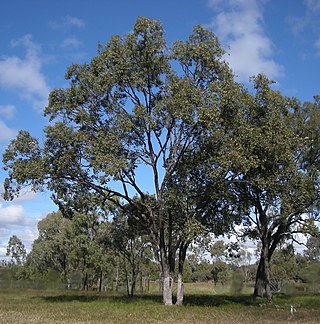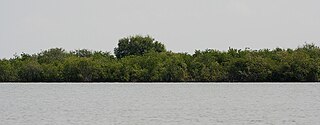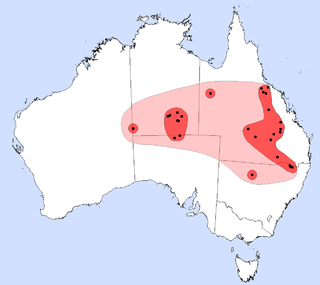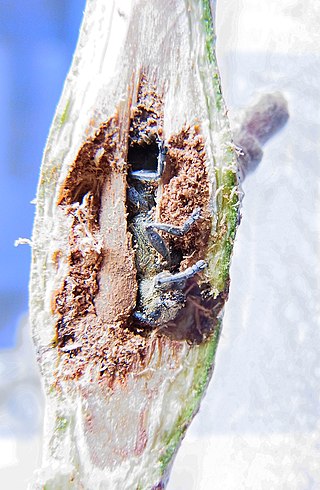
Convolvulaceae, commonly called the bindweeds or morning glories, is a family of about 60 genera and more than 1,650 species. These species are primarily herbaceous vines, but also include trees, shrubs and herbs. The tubers of several species are edible, the best known of which is the sweet potato.

Hibiscus is a genus of flowering plants in the mallow family, Malvaceae. The genus is quite large, comprising several hundred species that are native to warm temperate, subtropical and tropical regions throughout the world. Member species are renowned for their large, showy flowers and those species are commonly known simply as "hibiscus", or less widely known as rose mallow. Other names include hardy hibiscus, rose of sharon, and tropical hibiscus.

Thespesia is a genus of 14 flowering shrubs and trees in the Hibiscus family, Malvaceae, although within the family they are more closely related to cotton plants (Gossypium). The genus is distributed from the South Pacific through Asia, Africa, and the Caribbean.

Thespesia populnea, commonly known as the portia tree, Pacific rosewood, Indian tulip tree, or milo, among other names, is a species of flowering plant belonging to the mallow family, Malvaceae. It is a tree found commonly on coasts around the world. Although it is confirmed to be native only to the Old World tropics, other authorities consider it to have a wider, possibly pantropical native distribution. It is thought to be an invasive species in Florida and Brazil.

Hololepta plana is a beetle belonging to the Histeridae family.

Eucalyptus populnea, commonly known as poplar box, bimble box or bimbil box, is a species of small to medium-sized tree that is endemic to eastern Australia. It has rough, fibrous or flaky bark on the trunk and branches, egg-shaped, elliptical or more or less round leaves, flower buds arranged in groups of seven to fifteen or more, white flowers and conical, hemispherical or cup-shaped fruit.

Krishna Wildlife Sanctuary is a wildlife sanctuary and estuary located in Andhra Pradesh, India. It is one of the rarest eco-regions of the world because it harbors vast tracts of pristine mangrove forests. It is believed by conservationists to be one of the last remaining tracts of thick primary mangrove forests of South India, which is rapidly disappearing due to absence of protective measures.
Crataegus iracunda, with common name passionate hawthorn, and sometimes called the stolon-bearing hawthorn is a North American species of hawthorn. It was described in 1899 by Chauncey Delos Beadle of the Biltmore Herbarium in North Carolina. Taxonomic opinions have differed about this species, and to complicate matters Crataegus macrosperma and various species of C. series Populneae have frequently been misidentified as C. iracunda, leading to differing statements about its geographic range. The 2015 Flora of North America considers its range to be in the southeastern U.S., restricted to the US states of Alabama, Georgia, Louisiana, Mississippi, North Carolina, South Carolina, and Virginia.

Stigmella hoheriae is a species of moth of the family Nepticulidae. This day flying moth is found in New Zealand in both the North and South Islands. It inhabits native forest. Eggs are laid on the surface of a still growing leaf of a host plant. Larvae feed on Hoheria species such as Hoheria glabrata, Hoheria populnea, Hoheria sexstylosa and Hoheria angustifolia and have been recorded from February to August. The larvae of S. hoheriae are leaf miners. Their mines create blotches on the host plant leaves. S. hoheriae larvae pupate in a silk cocoon on the ground at the base of their food plant. Adult moths have been observed on the wing in February and from July to December. This species is rarely noticed as it is very small and as a result does not tend to attract attention when on the wing.

Hoheria populnea, commonly known as New Zealand mallow, lacebark or houhere, is a species of flowering plant in the family Malvaceae, endemic to New Zealand.

Setirostris eleryi is a species of small insectivorous bat found in inland eastern Australia. It is the sole species of the molossid genus Setirostris, a name that refers to the coarse bristles on their faces. Earlier common names have referred to this unique feature, and the 'free-tail' that is a common feature of its microchiropteran family, the Molossidae; no single common name emerged during the taxonomic revisions that identified what was referred to as the bristle-faced freetail.

Hololepta aequalis is a species of beetle belonging to the Histeridae family. It is found in North American countries such as Canada and the United States where it lives on an elevation of 525–1,370 metres (1,722–4,495 ft) and feeds on dead poplars. Besides poplars, it also feeds on pines, willows, and tulips. Its body is flat and is 8–11.5 millimetres (0.31–0.45 in) long. Its annuli is V-shaped while its palpi is horizontally projecting in front of the head. The species' antennal lobe is under anterior angles of its prothorax while its labrum is free.
Series Populneae is a series within the genus Crataegus that contains at least eight species of hawthorn trees and shrubs, native to Eastern North America. Only one species, C. populnea is widespread.

Saperda populnea, the small poplar borer, is a species of beetle in the family Cerambycidae which forms woody galls on twigs of poplars and willows. It was described by Carl Linnaeus in 1758.
Hololepta vernicis is a species of clown beetle in the family Histeridae. It is found in Central America and North America.

Hololepta is a genus of clown beetles in the family Histeridae. There are at least 100 described species in Hololepta.

Dysdercus andreae, or St. Andrew's cotton stainer, is a species of red bug in the family Pyrrhocoridae. It is found on islands in the Caribbean Sea and in North America. Its host plant is Thespesia populnea, which it feeds on the seeds and fruits of.
Hololepta lucida is a species of clown beetle in the family Histeridae. It is found in North America.
Hololepta vicina is a species of clown beetle in the family Histeridae. It is found in North America.
Hololepta minuta is a species of clown beetle in the family Histeridae. It is found in the Caribbean Sea, Central America, North America, and South America.












